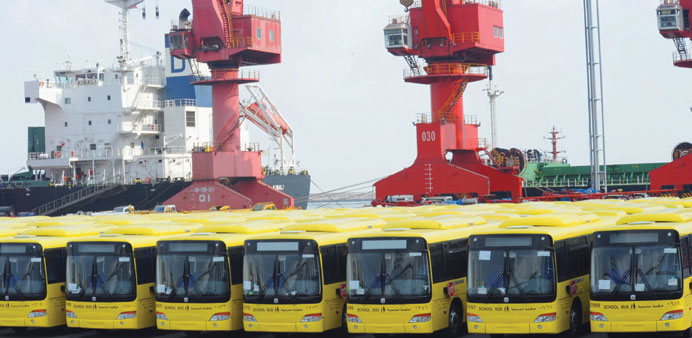Reuters
Beijing
China’s buoyant exports pushed its trade surplus to a record in July, fuelling optimism global demand will help counter pressure on the domestic economy from a weakening property sector.
While manufacturing appears to have picked up in the world’s second-largest economy, unexpected weakness in the services sector this week has renewed concerns about the growth outlook. The weak housing market remains China’s biggest risk, posing a drag on the broader economy and investor confidence.
Recovering global demand may not be enough to bolster a weak internal economy weighed by a cooling property sector and Beijing’s anti-corruption drive, suggesting policy support will likely continue to keep economic growth on track, analysts say.
Exports in July jumped 14.5% from a year earlier – the fastest pace in 15 months, the General Administration of Customs said yesterday, doubling from 7.2% in June and roundly beating market expectations. Exports were stronger than expected even after pricing in inflated export data in early 2013, when firms falsified invoices to skirt capital curbs. Some analysts attributed the export spurt to delayed shipments caused by recent volatility in the yuan which may not sustain. Meanwhile, imports fell 1.6% versus a rise of 5.5% in June, leaving the country with a record trade surplus of $47.3bn for the month.
“The (export) data indicates very strong demand externally and less need for a weak currency,” said Dariusz Kowalczyk, senior economist at Credit Agricole CIB in Hong Kong.
“However, imports contracted 1.6% year-on-year, indicating soft domestic demand and a downward pressure on growth. Policymakers are likely to do more to support the domestic economy.” A Reuters poll had predicted a 7.5% rise in exports, a 3% increase in imports and a trade surplus of $27bn.
Financial markets firmed on the data with the Shanghai Composite Index rebounding. It rose 0.25% by midday from its intraday low, when it was down 0.32%.
After a weak start this year, China’s exports have shown signs of improvement helped by stronger global growth as well as supportive domestic policies and the effects of a weaker yuan.
Exports to the US, China’s top export destination, rose 12.3% in June, quickening from a rise of 7.5% in June, while those to the European Union, the second-biggest market, grew 17%, compared with 13.1% in June.
Exports to Asean countries rose 11.9% in July, accelerating from 9.7% in June, the customs data showed.
Customs spokesman Zheng Yuesheng told state television that China exports are likely to stay strong in the coming months.
“The external demand is improving as a recovery in major developed countries underpins the global economy,” he said.
Imports from China’s largest source for resources, Australia, dropped 5.7%, partly due to softer commodity prices but the fall adds to questions over the health of domestic demand. Some analysts attributed weak imports to the crackdown on commodity financing following the Qingdao port fraud probe.
Combined exports and imports grew 2% in the first seven months from a year earlier, trailing far behind the government’s full-year target of 7.5%. The record trade surplus and pressure from capital inflows were seen renewing pressure on the yuan. The currency is poised for its third consecutive day of gains as the central bank signalled it was comfortable with stronger levels as the economy was improving.
“With Chinese economic activity improving, we believe that there is scope for RMB to further appreciate, driven by conversion of onshore FX deposits and increased foreign portfolio inflows,” analysts at ANZ said in a note.
That could create a fresh headache for China’s central bank, which intervened to weaken the currency earlier this year when it punished speculators betting on one-way yuan appreciation.
Chinese leaders have pledged to maintain pro-growth policies to help achieve the annual growth target of 7.5%. The government unveiled a burst of “targeted” policy stimulus since April, including cutting reserve requirements for some banks, hastening construction of railways and public housing and allowing local governments to loosen property curbs.



